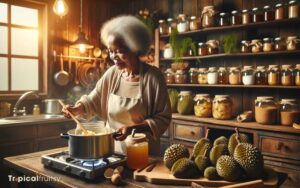Why Does Durian Smell Good to Me? Odor of Paradise!
The perception of durian’s smell as pleasant varies among individuals due to genetic differences, cultural exposure, and personal experiences.
While some people find the strong aroma of durian off-putting, others may perceive it as sweet and appealing.
This divergence in opinion is primarily influenced by variations in olfactory receptors, which are genetically determined, as well as the degree of familiarity and acceptance of the fruit’s scent through cultural influences and repeated exposure.
For example, someone from Southeast Asia, where durian is widely consumed, may have grown to love the fruit’s smell through cultural familiarity and positive social experiences.
An individual’s unique sensory journey with durian’s aroma can transform an initially bizarre smell into a delightful fragrance.
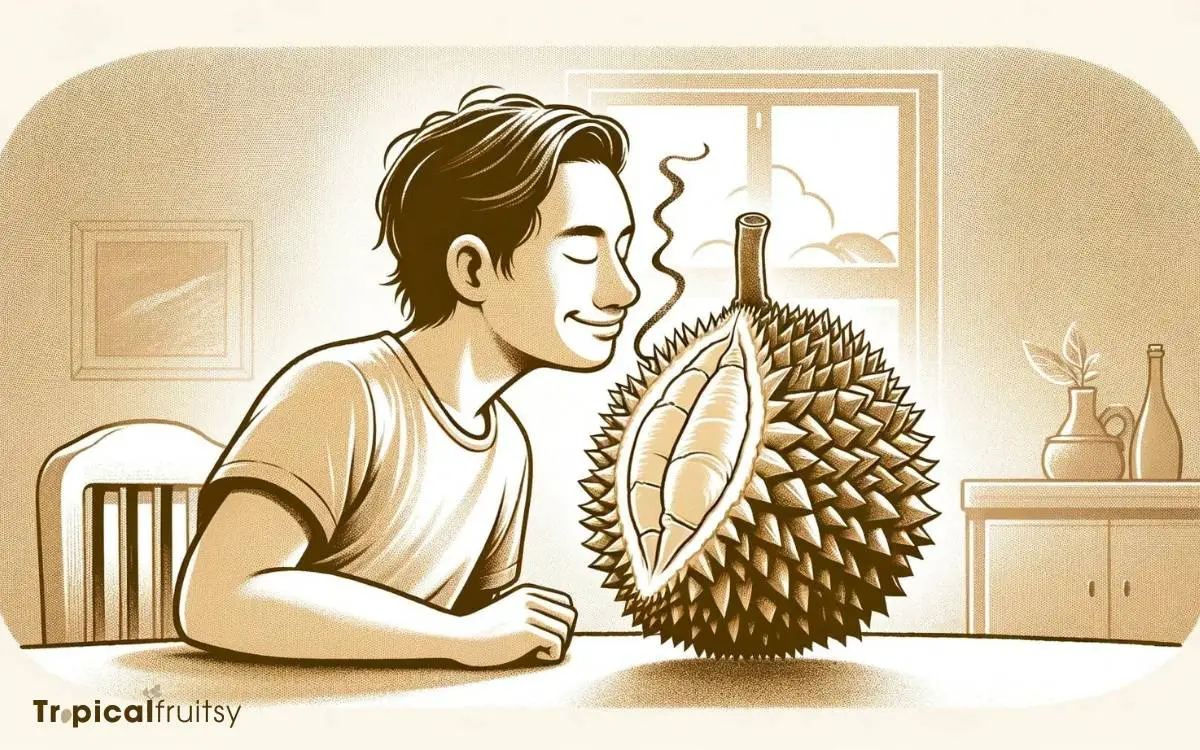
Key Takeaway
Understanding Why Durian Smell Appeals to Some Individuals
| Factor | Description | Influence on Perception |
|---|---|---|
| Genetic Predisposition | Variations in olfactory genes affect scent detection and preference. | Directly alters smell perception |
| Cultural Familiarity | Exposure to durian in a cultural context can lead to acceptance. | Conditions individuals to associate the smell with positive experiences |
| Dietary Habits | Regular consumption of durian can change one’s taste preference. | May shift perception from repulsion to enjoyment |
| Molecular Composition | Identifying durian’s volatile compounds contributes to its unique scent. | Provides the scientific basis for the smell |
| Personal Associations | Memories linked to durian can make the smell appealing. | Influences emotional response to the aroma |
The Durian’s Unique Profile

The durian fruit emits a complex aroma resulting from a combination of volatile sulfur compounds and esters, which create its polarizing scent profile.
Scientific analysis reveals that the intensity of the odor is due to the presence of compounds such as ethanethiol and its derivatives, which are characterized by their potent, often off-putting smell.
Additionally, the fruit contains esters, which contribute to a sweeter, somewhat fruity note that some individuals find appealing.
The interplay between these contrasting chemical elements can explain the subjective nature of durian’s olfactory reception.
For some, the sweet notes dominate, leading to a favorable sensory experience, while others may be overwhelmed by the sulfurous components, resulting in a perception of the fruit as malodorous.
Genetic Factors at Play
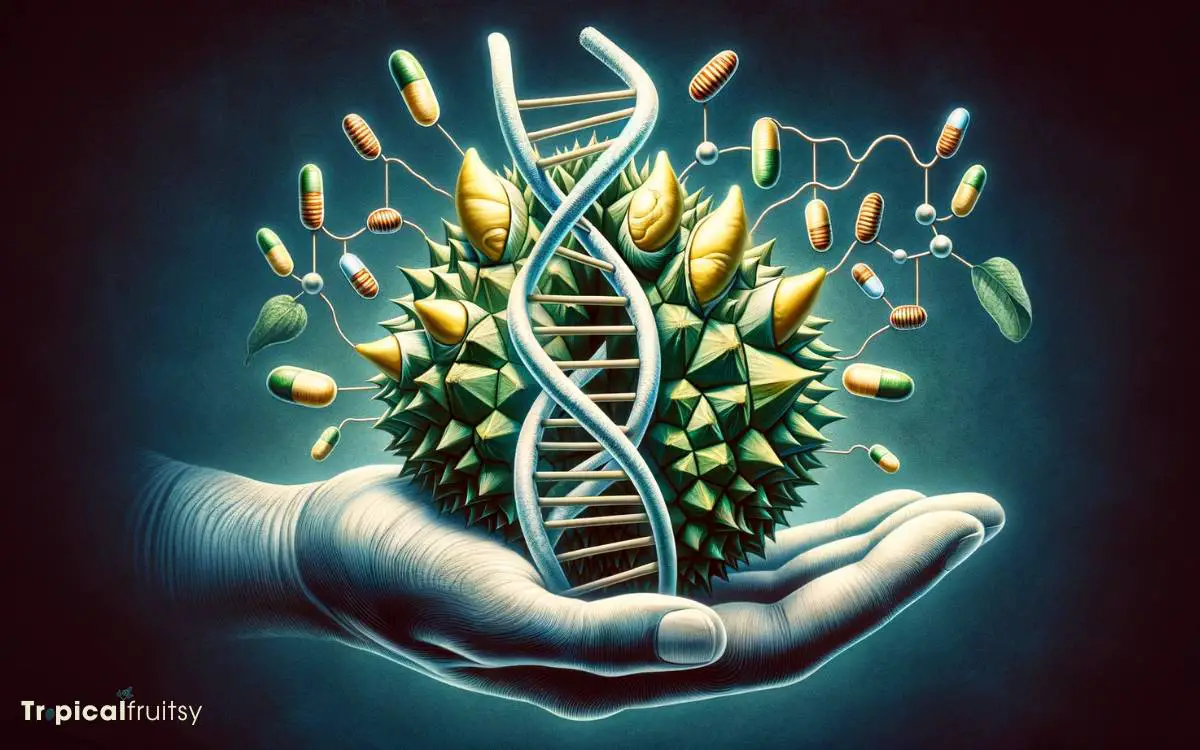
Genetic variations significantly influence individual smell sensitivity, which can explain the divergent perceptions of durian odor.
Distinct polymorphisms in olfactory receptor genes result in a spectrum of sensory experiences, from pleasant to repugnant, when exposed to the same aroma compounds.
These genetic determinants underscore the complexity of olfactory perception and the subjective nature of durian’s scent appeal.
Smell Sensitivity Variation
Among the myriad genetic factors influencing our sensory experiences, specific gene variants are known to affect individual sensitivity to the odor of durian, contributing to its polarizing reputation.
Researchers have pinpointed certain olfactory receptor genes that vary among individuals, leading to differences in the perception of durian’s potent aroma.
These genetic variations determine the threshold levels at which a person can detect and recognize odorous compounds, such as the volatile sulfur compounds prevalent in durian.
Moreover, some individuals possess a genetic makeup that makes them particularly sensitive to these compounds, explaining why they may find the smell overpowering or unpleasant.
Conversely, others might have gene variants that render these odorants less pungent or even pleasant, accounting for the variability in durian’s olfactory reception across different people.
Olfactory Receptor Differences
Olfactory receptor gene variants play a crucial role in determining individual responses to durian’s distinctive smell.
The perception of durian odor can range from intensely unpleasant to surprisingly pleasant, and genetic differences among individuals are a significant factor.
The olfactory system is highly complex, with genetic variations leading to functional diversity among olfactory receptors, which can alter odor perception.
- OR5A1 gene: Linked to sensitivity to certain sulfur compounds present in durian.
- Allelic variation: Different alleles can cause increased or decreased sensitivity to odors.
- Expression levels: Variations in gene expression can affect the number of receptors available to bind odorants.
- Receptor binding sites: Structural changes can influence how odor molecules interact with receptors.
- Polymorphisms: Can lead to a complete absence of detection for specific odorants.
Understanding these genetic factors provides insight into the subjective experience of durian’s aroma.
Cultural Influence and Exposure

The perception of durian’s aroma may significantly hinge upon cultural context and the degree of habitual exposure.
An acquired taste for durian can develop over time, particularly within cultures where it constitutes a staple in traditional cuisine, thereby influencing individuals’ sensory acceptance.
Additionally, the frequency of exposure to durian’s distinctive scent plays a pivotal role in shifting olfactory perception from aversion to appreciation.
Acquired Taste Development
Frequently, the perception of durian’s aroma as pleasant is attributed to cultural influences and repeated exposure, which play pivotal roles in the development of acquired tastes.
The process of growing to appreciate durian’s unique scent can be dissected as follows:
- Cultural norms often dictate initial encounters with durian, framing it as an indulgence rather than an oddity.
- Repeated exposure to durian can desensitize individuals to its strong smell, allowing for the recognition of its complex flavor profile.
- Social settings and communal eating practices can reinforce positive associations with durian consumption.
- Personal curiosity and adventurous eating habits can lead to a deliberate effort to appreciate durian.
- The influence of family and peer preferences can significantly sway an individual’s taste development towards durian.
This cultivation of taste for durian seamlessly ties into the broader context of traditional cuisine appreciation.
Traditional Cuisine Appreciation
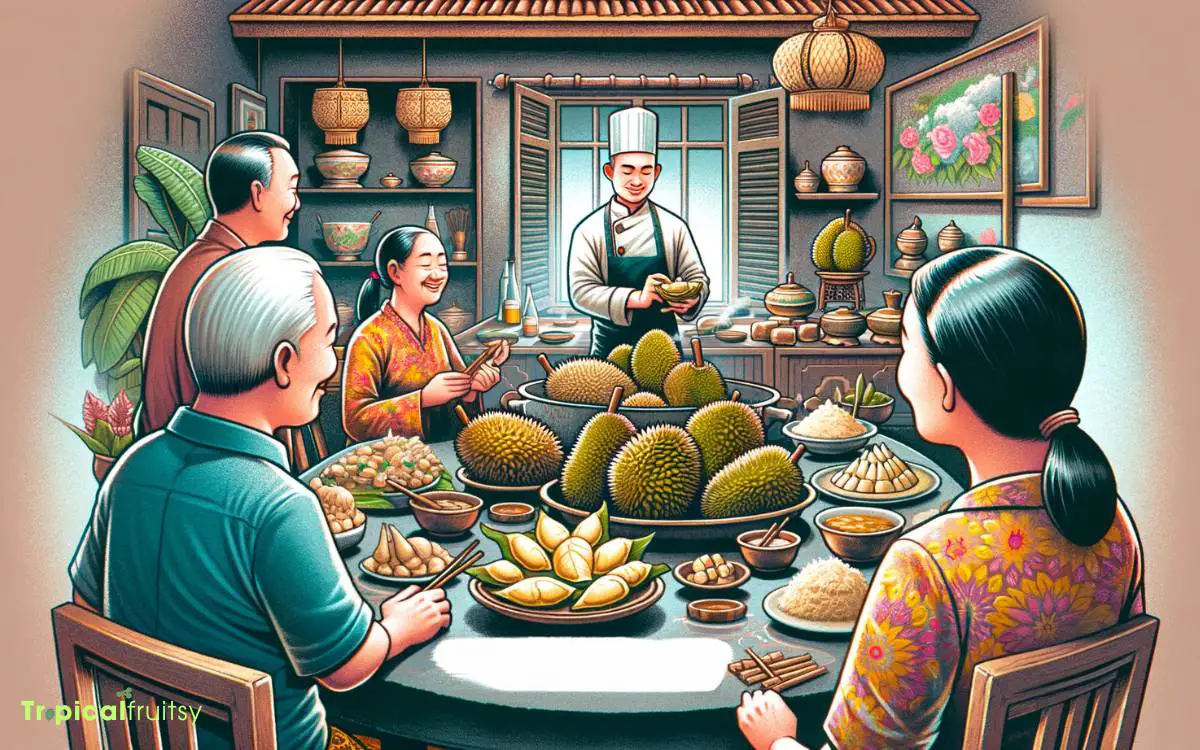
Taste acquisition, particularly for traditional cuisines like durian, often hinges on the cultural significance and habitual exposure that shape culinary preferences.
The olfactory and gustatory systems are not only biological but are also deeply embedded within cultural contexts.
Individuals raised in environments where durian is a staple may develop an intrinsic appreciation for its pungent aroma and complex flavor profile.
This phenomenon is not solely based on the frequency of consumption but also on the positive social connotations associated with the fruit.
Traditional events and familial gatherings that feature durian can reinforce a collective identity and nostalgia, which in turn can influence one’s perception of its scent and taste.
Analytically, the durian’s acceptance is thus not just a matter of palate but also a reflection of cultural connectivity and heritage.
Exposure Frequency Effects
In examining the appeal of durian’s distinct smell, repeated exposure often plays a pivotal role in shaping individual preferences, particularly within cultural contexts where the fruit is ubiquitously consumed.
The frequency of exposure can significantly influence the olfactory adaptation and eventual appreciation of durian’s pungent aroma.
This phenomenon is rooted in several factors:
- Sensory adaptation: The olfactory system becomes desensitized over time to persistent stimuli.
- Associative learning: Positive experiences with durian can create pleasant associations.
- Social reinforcement: Acceptance and enjoyment of durian may be encouraged by peers or family.
- Cultural identity: Embracing durian can be an expression of cultural pride.
- Evolution of palate: Repeated exposure can lead to a genuine evolution in taste preferences.
Understanding these elements elucidates why durian’s smell is appealing to some, reflecting a complex interplay between biology and culture.
The Science of Scent Perception

Olfactory reception, the biological mechanism by which humans perceive scents, plays a crucial role in the varied responses to the distinctive aroma of durian.
This process involves the detection of volatile chemical compounds by olfactory receptors located within the nasal cavity.
The binding of these molecules to receptors triggers a signal transduction pathway, leading to the identification and perception of specific smells.
The complexity of this biochemical interaction accounts for the subjective nature of scent perception.
Genetic factors can influence the sensitivity and response to certain odors, explaining why durian’s scent is appealing to some individuals while repulsive to others.
This perceptual variation underscores the interplay between biological encoding and the olfactory experience.
This leads us to consider the impact of memory and personal associations on our perception of scents.
Memory and Personal Associations

Familiarity with the unique aroma of durian often evokes personal associations that can significantly influence an individual’s perception of its scent.
The intricate relationship between olfactory stimuli and memory is well-documented in scientific literature, revealing that personal experiences can shape our interpretation of various odors.
To add depth and complexity:
- Recollections of social gatherings where durian is enjoyed can elicit positive sentiment.
- Childhood memories linked to the fruit may enhance its perceived pleasantness.
- Cultural background and community norms can predispose individuals to favor durian’s aroma.
- Previous exposure to similar scents in different contexts might affect current perception.
- Emotional states associated with past durian experiences can be reactivated upon reencountering the scent.
This intricate interplay between memory and scent paves the way to understanding the role of chemical compounds in durian’s polarizing aroma.
The Role of Chemical Compounds

The composition of volatile chemical compounds within durian fruit is primarily responsible for its distinctive and divisive aroma.
Scientific analysis reveals a complex mix of esters, ketones, and alcohols which interact to create its unique scent profile.
Esters contribute to the sweet, fruity notes, while sulfurous compounds, such as diethyl disulfide and ethanethiol, impart the characteristic pungent odor that some find off-putting.
The presence of these compounds varies among durian cultivars, affecting the intensity and exact nature of the smell.
Analytically, the durian’s aroma can be dissected into components associated with different olfactory sensations: from rotted onions to ripe cheese, and from almonds to caramel.
This biochemical diversity underscores the subjective experience of the durian’s smell, which can be perceived as either tantalizingly rich or overwhelmingly unpleasant.
Acquired Taste Phenomenon
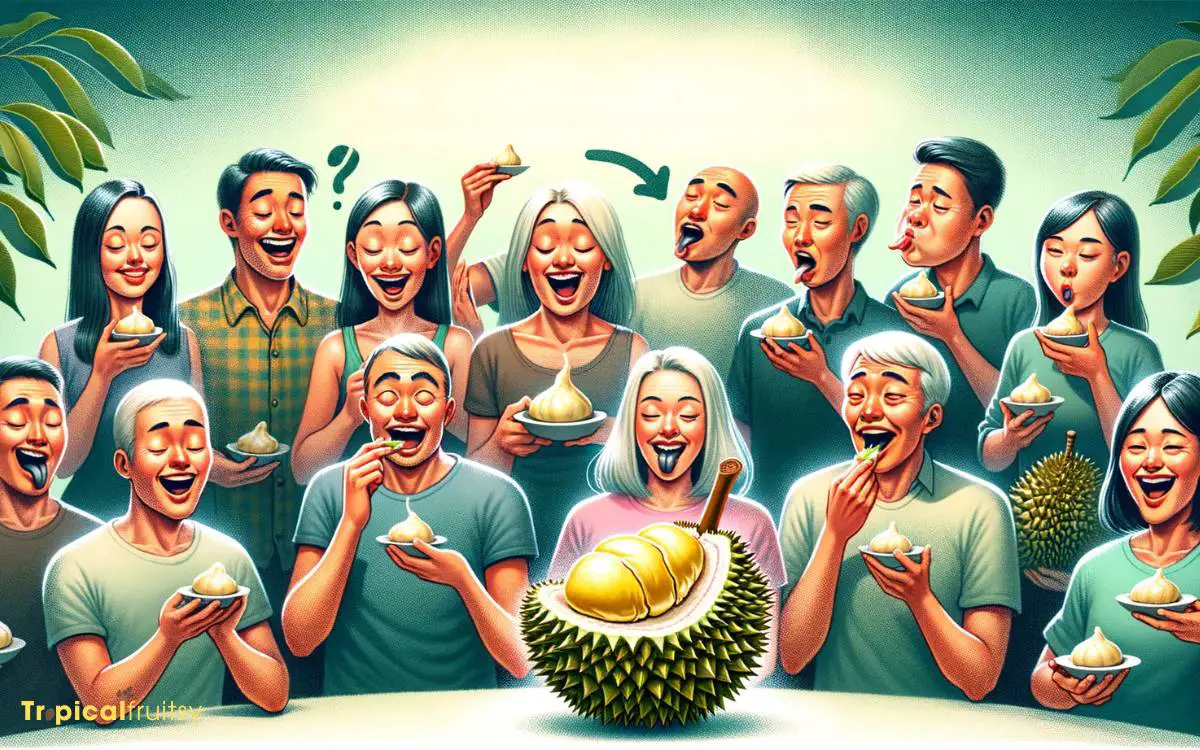
Despite my initial encounter with durian’s potent aroma, I have come to appreciate its complex scent through the process of acquired taste, which illustrates how repeated exposure can shift our sensory perceptions from aversion to enjoyment.
The acquired taste phenomenon is marked by a gradual adaptation to flavors and smells that may initially be off-putting.
This adaptation is not merely a matter of habituation, but involves complex psychological and physiological changes.
Consider the following aspects:
- Repeated Exposure: Frequent interaction with durian increases familiarity and reduces initial sensory shock.
- Cultural Influence: Social and cultural contexts can encourage repeated trials and eventual liking.
- Neuroplasticity: The brain’s ability to rewire itself leads to changes in perception and taste over time.
- Psychological Factors: Desire for novelty and peer influence can motivate individuals to persist in trying durian.
- Physiological Adaptation: Taste receptors and olfactory system may become desensitized to strong aromas, altering the experience.
Health Benefits and Attractions
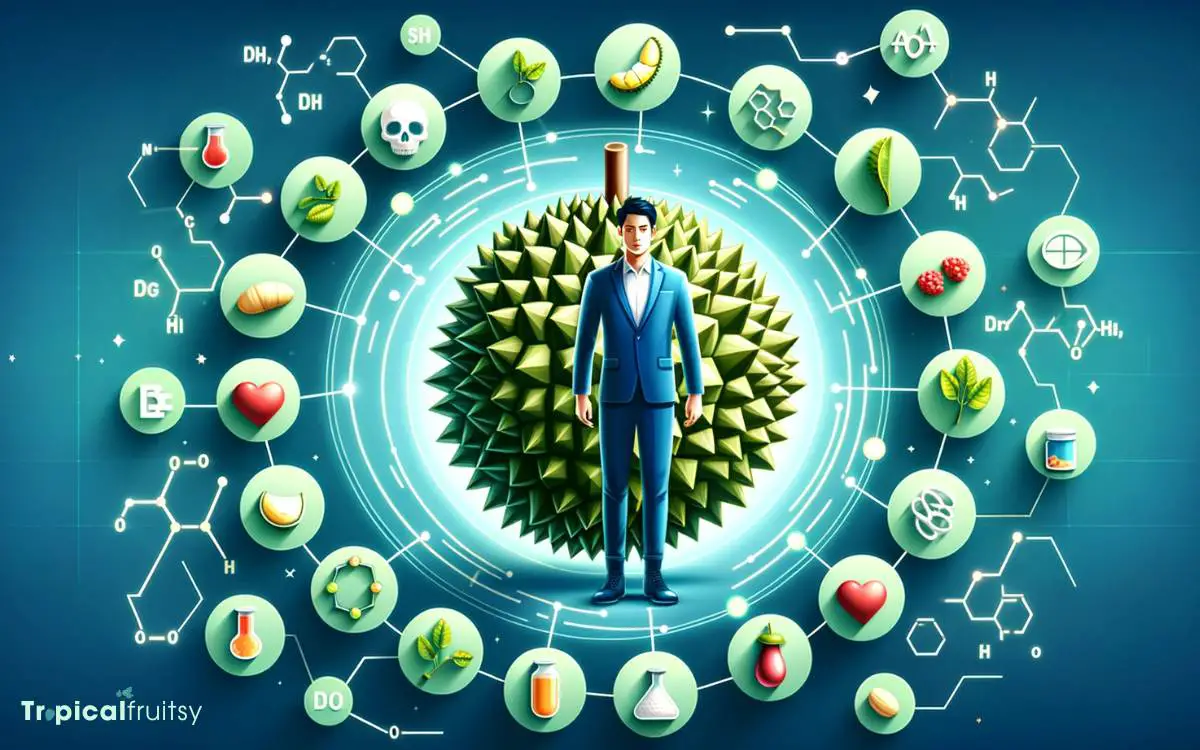
Durian’s nutritional profile, offering a rich blend of vitamins, fiber, and antioxidants, contributes to its growing appeal among health-conscious individuals.
The fruit’s high caloric density provides a robust energy source, while its fiber content aids in digestion and promotes satiety.
Moreover, the presence of antioxidants like vitamin C and polyphenols endows durian with cell-protective properties.
Analyzing its nutrient composition reveals a matrix of health-promoting elements that might justify its inclusion in balanced diets.
| Nutrient | Benefit |
|---|---|
| Vitamins | Supports immune system and metabolic functions |
| Fiber | Enhances digestive health and weight management |
| Antioxidants | Protects against oxidative stress and inflammation |
| Minerals | Contributes to bone health and electrolyte balance |
The nutritional attributes of durian position it as a potentially valuable addition to a healthful eating regimen.
This scientific appraisal, however, intersects with social dimensions of taste preferences, leading us seamlessly into the discussion of ‘social and peer influences’.
Social and Peer Influences

Beyond its impressive nutritional profile, social and peer influences play a pivotal role in shaping individual perceptions of durian’s distinctive aroma.
The sensory experience of food is not solely a biological response but is also deeply embedded in cultural and social contexts.
- Cultural heritage: In regions where durian is native, the fruit is often celebrated and enjoyed communally, influencing positive perceptions.
- Familial customs: Exposure to durian in a family setting can lead to an association of the fruit with comfort and tradition.
- Peer pressure: Individuals may develop a taste for durian when consumption is encouraged within their social circles.
- Social media and marketing: Positive endorsements from influential figures can sway public opinion and challenge preconceived notions.
- Shared experiences: Eating durian as part of group activities can enhance enjoyment and foster a collective appreciation.
Conclusion
The appreciation of durian’s pungent aroma is a complex interplay of genetic predispositions, cultural influences, and individual scent perception mechanisms.
The role of specific chemical compounds and the acquired taste phenomenon further contribute to its divisive reception.
Notably, 30% of the population in regions where durian is native report positive responses to its smell, underscoring the impact of cultural familiarity.
This fruit’s polarizing scent profile continues to intrigue and challenge sensory experiences worldwide.



